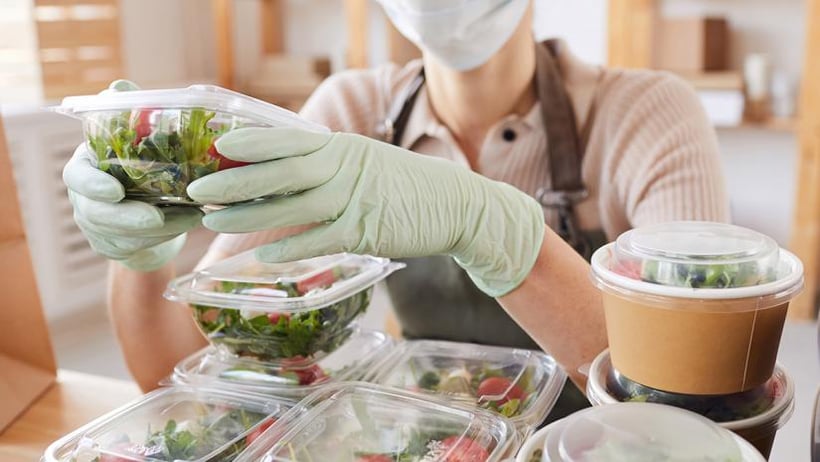
As more consumers use apps to get meals delivered, food businesses planning to offer delivery services must determine the delivery model that works best for their business. They can choose to use an app or employ someone on staff to provide delivery services to customers.
Using a delivery app can increase a restaurant’s exposure to those who aren’t familiar with their food business, while using in-house delivery drivers gives the business greater control over the quality of service. With either option, it’s important that businesses address any food safety concerns related to delivery services and still meet food safety standards.
To minimize food safety risks while transporting food, businesses providing any delivery option should follow these best practices.
Keep food out of the Temperature Danger Zone
Not only will customers be upset if their food arrives too cold, but food kept at certain temperatures can also increase the risk of causing a food-borne illness. The “Temperature Danger Zone” is the temperature range between 4°C and 60°C (5°C and 60°C in Manitoba) at which harmful bacteria can grow rapidly on food and cause food poisoning. Food should never be kept in the Temperature Danger Zone for longer than two hours. This means that customers should receive and eat or refrigerate their food before this time limit has passed.
When providing food delivery services, ensure that:
- insulated bags or coolers are used to transport food, keeping it at a safe temperature for longer
- a delivery range is in place so that food doesn’t have to travel to a far location where keeping it at a safe temperature would be unrealistic
- there is a tracking system in place to track the delivery
Additional delivery precautions for COVID-19
Follow these guidelines for delivering food during COVID-19, which include:
- following any masking rules that are implemented in your area, which could include ensuring delivery drivers wear masks when picking up food at the business and handing over food to customers
- ensuring delivery drivers: wash or sanitize their hands before picking up the delivery at the food business, apply hand sanitizer before handing over items to customers and wash their hands between deliveries
- properly sanitizing bags used to transport food
- stapling the delivery receipt or writing out the delivery information on the outside of the food packaging to avoid confusion about the recipient
Use quality food packaging
The packaging used to hold and deliver food has a big impact on keeping food intact, appealing and fresh. Using the right packaging also helps minimize food safety risks. Below are a few materials a food business can use for packaging and factors to keep in mind for each option. Food businesses should choose the best option for the types of food they are transporting.
- Plastic materials are strong and durable but do not hold moisture well. Keeping food in plastic packaging can lead to soggy dishes. Plastic packaging is also not very environmentally friendly.
- Styrofoam is inexpensive and a great material to help control the temperature of hot and cold foods but is also not environmentally friendly.
- Aluminum foil is sealable, non-absorbent and holds heat well. However, aluminum foil cannot be used in the microwave and can be expensive.
- Biodegradable materials such as paper and cardboard can hold moist food for longer while also being cost-effective and easily customizable to the food business’s branding.
- Sustainable packaging such as recyclable glass bottles are often more expensive, but better for the environment; they can be very strong and durable depending on the material used.
Follow food safety best practices
Building a strong culture of food safety within a food business goes a long way in preventing the spread of food-borne illnesses. Regardless of whether a business is providing dine-in, takeout or delivery services, all staff should follow these food safety best practices:
- follow correct hand-washing procedures
- avoid handling food when sick
- store food and ingredients properly
- employ the proper time and temperature controls, including ensuring food is cooked to the right temperature and limiting the time food is kept in the Temperature Danger Zone
- follow proper cleaning and sanitizing procedures, especially in high-touch areas
- avoid cross-contamination caused by biological, physical and chemical factors in the food business
Perform quality checks
Make sure these food safety standards are always followed. Food businesses should have someone on staff performing regular inspections to ensure all guidelines are met. This person should be trained in food safety best practices and how to minimize food safety risks.
Ensure your food business is implementing the best food safety standards not just for delivery services, but in all aspects of the business. The Canadian Institute of Food Safety (CIFS) offers a nationally recognized Food Handler Certification Course that provides comprehensive training on food safety, including proper food storage, time and temperature controls, cleaning and sanitizing procedures as well as proper hygiene protocols.




